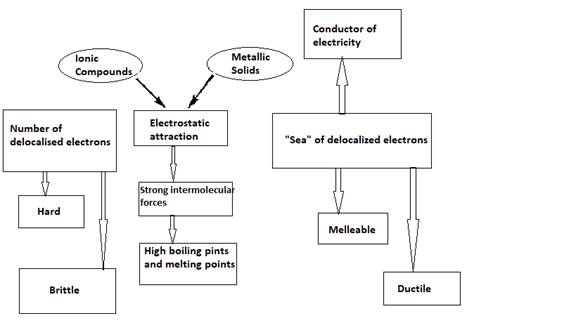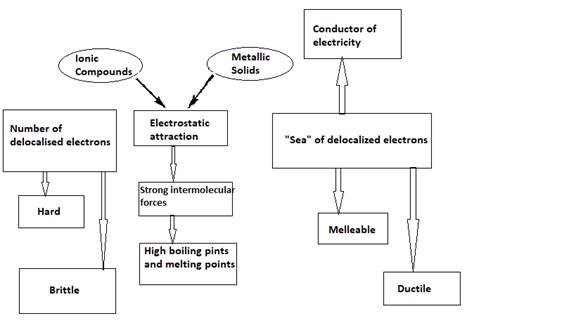
Interpretation:
A concept map needs to be designed to explain the physical properties of both ionic compounds and metallic compounds.
Concept introduction:
Both metallic compounds like AgNO3 and ionic compounds like LiF and LiCl have high melting and boiling points. Also, the molecules have strong intermolecular forces between them.
Answer to Problem 112A
A concept map explaining the physical properties of ionic compounds and metallic compounds is as follows:

Explanation of Solution
Metallic Solids are malleable, durable and show ductility and are also good conductors of electricity. They have high melting and high boiling points and are held together by intermolecular forces.
Ionic solids are bad conductors of electricity and are hard and brittle. They have high melting and high boiling points and are held together by intermolecular forces.
A concept map explaining the physical properties of ionic compounds and metallic compounds.


A concept map explaining the physical properties of ionic compounds and metallic compounds.
Chapter 7 Solutions
Chemistry: Matter and Change
Additional Science Textbook Solutions
Introductory Chemistry (5th Edition) (Standalone Book)
Organic Chemistry (9th Edition)
Inorganic Chemistry
Chemistry: The Central Science (14th Edition)
Chemistry: Structure and Properties (2nd Edition)
Chemistry: The Central Science (13th Edition)
 ChemistryChemistryISBN:9781305957404Author:Steven S. Zumdahl, Susan A. Zumdahl, Donald J. DeCostePublisher:Cengage Learning
ChemistryChemistryISBN:9781305957404Author:Steven S. Zumdahl, Susan A. Zumdahl, Donald J. DeCostePublisher:Cengage Learning ChemistryChemistryISBN:9781259911156Author:Raymond Chang Dr., Jason Overby ProfessorPublisher:McGraw-Hill Education
ChemistryChemistryISBN:9781259911156Author:Raymond Chang Dr., Jason Overby ProfessorPublisher:McGraw-Hill Education Principles of Instrumental AnalysisChemistryISBN:9781305577213Author:Douglas A. Skoog, F. James Holler, Stanley R. CrouchPublisher:Cengage Learning
Principles of Instrumental AnalysisChemistryISBN:9781305577213Author:Douglas A. Skoog, F. James Holler, Stanley R. CrouchPublisher:Cengage Learning Organic ChemistryChemistryISBN:9780078021558Author:Janice Gorzynski Smith Dr.Publisher:McGraw-Hill Education
Organic ChemistryChemistryISBN:9780078021558Author:Janice Gorzynski Smith Dr.Publisher:McGraw-Hill Education Chemistry: Principles and ReactionsChemistryISBN:9781305079373Author:William L. Masterton, Cecile N. HurleyPublisher:Cengage Learning
Chemistry: Principles and ReactionsChemistryISBN:9781305079373Author:William L. Masterton, Cecile N. HurleyPublisher:Cengage Learning Elementary Principles of Chemical Processes, Bind...ChemistryISBN:9781118431221Author:Richard M. Felder, Ronald W. Rousseau, Lisa G. BullardPublisher:WILEY
Elementary Principles of Chemical Processes, Bind...ChemistryISBN:9781118431221Author:Richard M. Felder, Ronald W. Rousseau, Lisa G. BullardPublisher:WILEY





